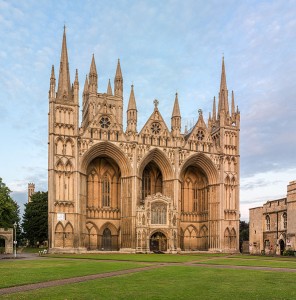 On this day in history, 29 January 1536, Henry VIII’s first wife, Catherine of Aragon, was laid to rest at Peterborough Abbey (now Peterborough Cathedral). She had died on 7 January 1536 at Kimbolton Castle.
On this day in history, 29 January 1536, Henry VIII’s first wife, Catherine of Aragon, was laid to rest at Peterborough Abbey (now Peterborough Cathedral). She had died on 7 January 1536 at Kimbolton Castle.
Catherine had left instructions for her remains to be buried in a Chapel of her beloved order, The Observant Friars, but the recent dissolution of the monasteries meant that there were none left. She was buried in Peterborough Abbey as the Dowager Princess of Wales, having been stripped of the title of “Queen” in 1533 after Henry VIII’s marriage to Anne Boleyn and the annulment of his marriage to Catherine. However, her grave is now marked “Katharine Queen of England”.
In his recent biography of Catherine of Aragon, historian Patrick Williams gives details of the preparations for Catherine’s burial. After her body had been disembowelled by one of her servants, her body was taken to the Privy Chamber at Kimbolton, the castle which had been Catherine’s home since May 1534, where it was placed under a canopy of state. It remained that way until 15th January when it was finally encased in a lead coffin, in preparation for burial, and taken to the castle’s chapel, where it stayed until 27th January.
Williams writes of how solemn masses were said while Catherine’s remains were in the chapel and that these masses were attended by noble ladies like the Duchess of Suffolk and the Countesses of Worcester, Oxford and Surrey. On 26th January, a formal dinner was held with the Countess of Surrey acting as chief mourner. On 27th January, a mass was celebrated and then Catherine’s coffin began its journey to Peterborough. Williams describes how the procession consisted of a crucifer, sixteen priests and gentlemen, Catherine’s chamberlain and steward carrying their rods of office, around ten heralds wearing mourning hoods, the wagon bearing the coffin and escorted by thirty-six maids and fifty servants of the gentlemen all carrying torches, seven ladies acting as chief mourners, and nine ladies who were the wives of local knights.
The procession halted at Sawtry Abbey, nine miles from Kimbolton, and Catherine’s coffin was taken to the choir of the church there and placed under a canopy. Williams describes how Abbot William Angell burned 408 candles in an overnight vigil.

On 28th January, a mass was led by Thomas Goodrich, Bishop of Ely, before the coffin set off on the last leg of its journey to Peterborough. At Peterborough Abbey, Abbot John Chambers and the Bishops of Lincoln, Ely and Rochester greeted the procession at the abbey door and then the coffin was processed to the mourning chapel which was “lavishly hung with eighteen banners which emphasised Katharine’s status in the royal families of England and Spain: among them were those of Charles V, Henry VIII, Queen Isabella and Prince Arthur, Katharine’s sister, the Queen of Portugal; those of Castile, Aragon, Sicily and England; and that of John of Gaunt.” There were also pennants displaying the arms of Catherine and her father, Ferdinand II of Aragon, and golden letters spelled out her motto “Humble and Loyal”.
Catherine was buried on 29th January with Eleanor Brandon, daughter of Charles Brandon, Duke of Suffolk, acting as chief mourner and Sir William Paulet representing Henry VIII. John Hilsey, Bishop of Rochester, preached the homily “speaking against the power of ‘the Bishop of Rome’ and the marriage of Katharine and Henry VIII” and “insisting that she had never been Queen of England”. Catherine’s chaplain, George de Athequa, Bishop of Llandaff, was, however, allowed to serve one of the masses said at Peterborough as deacon.
Rest in Peace Queen Catherine of Aragon.
Peterborough Cathedral commemorates her death and burial, and celebrates her life on an annual basis with a special programme of events known as the Katharine of Aragon Festival. Here is the programme for this year’s festival:
- Friday 30th January – 10.30am Service of Commemoration at Peterborough Cathedral, followed by a Tudor history day for schools.
- Friday 30th January – 2pm Guided Tour of the Cathedral.
- Friday 30th January – 7.30pm talk by Alison Weir: The Exile of Katharine of Aragon
- Saturday 31st January – 10.00am–5.00pm: At home with the Tudors, at Peterborough Museum
- Saturday 31st January – 2pm Guided Tour of the Cathedral.
- Saturday 31st January – 7.30pm Monteverdi’s Vespers of 1610, sung by The Sixteen at Peterborough Cathedral.
- Sunday 1st February – 10.00am–5.00pm: At home with the Tudors, at Peterborough Museum
- Sunday 1st February – 2pm Tudor Peterborough Walk, starts at Peterborough Museum.
See http://www.peterborough-cathedral.org.uk/katharine-of-aragon-festival-2015.html for more details and to buy tickets.
Notes and Sources
- Extract taken from 29 January 1536 – The Burial of Catherine of Aragon
- Williams, Patrick (2013) Katharine of Aragon, p375-376
- Photo of Peterborough Cathedral by DAVID ILIFF. License: CC-BY-SA 3.0